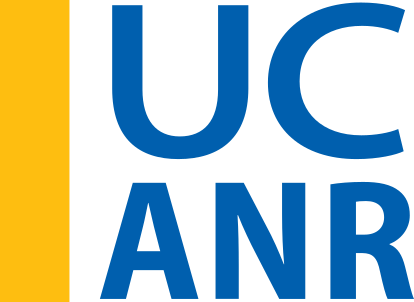- Author: Kathy Keatley Garvey
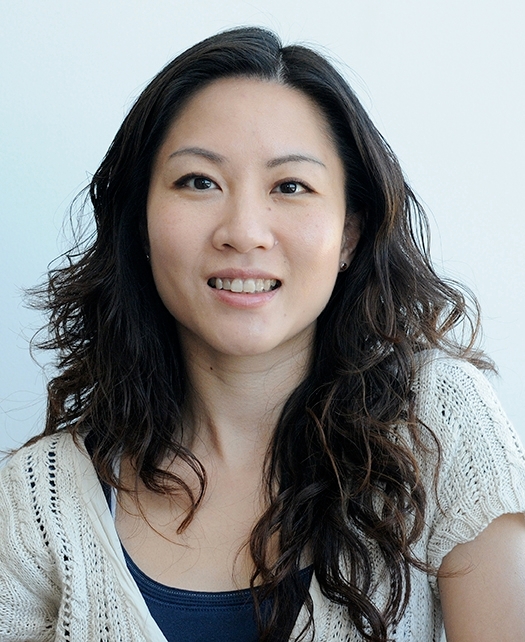
Those are some of the roles of Professor Joanna Chiu, molecular geneticist and physiologist, who advanced from vice chair to chair of the UC Davis Department of Entomology and Nematology on July 1. She is serving a five-year appointment, succeeding nematologist Steve Nadler, the chair since Jan. 1, 2016.
As Dean Helene Dillard of the UC Davis College of Agricultural and Environmental Sciences said today: "I am pleased Joanna Chiu has been appointed as the chair of the Department of Entomology and Nematology. She is an outstanding scholar and teacher with demonstrated leadership skills. I look forward to watching Professor Chiu thrive in her new role as chair and seeing the department continue to flourish.”
Chiu joined the Department of Entomology and Nematology in 2010 as an assistant professor, and advanced to associate professor and vice chair in 2016, and to professor and vice chair in 2021. She was named one of 10 UC Davis Chancellor's Fellows in 2019, a five-year honor awarded to associate professors who excel in research and teaching. The UC Davis Academic Senate honored her with a Distinguished Teaching Award, Graduate/Professional category, in 2022. She most recently received the Chancellor's Award for Excellence in Mentoring Undergraduate Research.
Chiu co-founded and co-directs (with professors Jay Rosenheim and Louie Yang) the campuswide Research Scholars Program in Insect Biology, launched in 2011 to provide undergraduates with a closely mentored research experience in biology. The program's goal is to provide academically strong and highly motivated undergraduates with a multi-year research experience that cultivates skills that will prepare them for a career in biological research.

"I grew up not knowing any scientists,” she related. “Both my parents work in the financial industry and neither went to college. However, my dad loves the outdoors and my childhood memories includes snorkeling with my dad and siblings, hiking in the very limited outdoors in my native Hong Kong, and watching a lot of National Geographic on TV. As a result, I have always been curious about biology, especially animal behavior. I really hoped to study biology in college. My parents, on the other hand, wanted me to be a doctor."
“I certainly have never ever dreamed of being a professor when I was a college student. I just know I love biological research so I can learn more about the natural world, I love asking questions, and I love the joy of discovery."
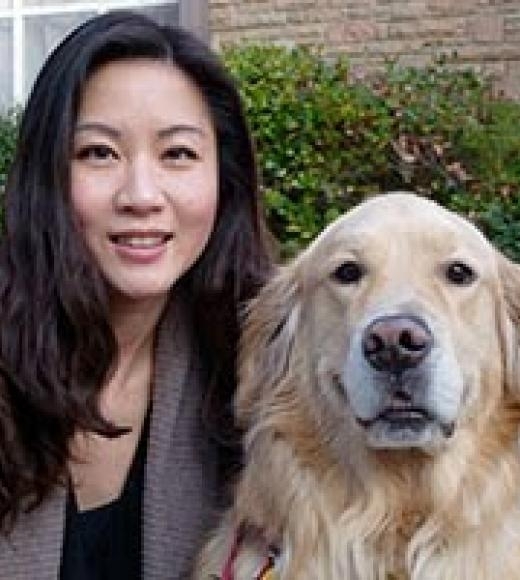
In nominating Chiu for the Chancellor's Award for Excellence in Mentoring Undergraduate Research, then doctoral Christine Tabuloc (now a PhD) wrote: "I joined Dr. Chiu's laboratory at the beginning of my second year here at UC Davis and remained a member of the lab for 3 years as an undergraduate, 2 years as a technician, and 6 years as a graduate student."
"Dr. Chiu welcomed me into her lab back in 2012," Tabuloc noted. "I had just finished my first year of college, and I had virtually no research experience. Despite this, Joanna took a chance on me and invited me to join her lab. Throughout the years, Joanna has taught me many skills—both at the bench and skills that translate outside the lab and even beyond academia. Joanna has taught me everything I know from performing an experiment with all the proper controls to mentoring students and giving effective and clear presentations. What makes her so outstanding is her commitment to helping us improve as scientists and researchers and preparing us for our future career endeavors."
"Not only have I experienced Dr. Chiu's mentorship first-hand, but I have also had the privilege of watching her mentor all the undergraduate students that have joined her lab throughout the years. In fact, since my time here, I have watched at least 35 undergraduates be mentored by Joanna, and many of these students were authors on publications in peer-reviewed journals such as Scientific Reports, Journal of Pest Science, BMC, Ecology, Current Biology, Nature Communications, Journal of Economic Entomology,and PLOS Genetics. More so, a true testament to her success as an undergraduate mentor are her students' successes: furthering their education at academic institutions such as Cornell, Stanford, Columbia, UCB, and UCLA or landing industry jobs at companies such as 10X Genomics. Many of these students still keep in contact with Dr. Chiu, and she continues to provide advice and guidance such as reviewing resumes and helping them prepare for interviews. Joanna is not just our mentor when we are at UCD, she is our mentor for life."
Other comments in the nomination awards packet echo Tabuloc's words:
- "As a PhD student at Cornell, I am immensely grateful for the training I received as an undergrad from Dr. Chiu. Not only did she train me thoroughly in basic biochemistry and molecular biology techniques, but she also pushed me to be independent and think critically about my science, skills essential for graduate school."--Jessica West
- "Beyond teaching me practical research skills, Dr. Chiu helped to spark the most important thing a person needs to be a successful scientist: pure joy in the pursuit of knowledge."--Katie Freitas
Joanna Chiu: scholar, teacher, mentor, researcher, author, collaborator, leader, optimist and administrator. But we should add at least one other attribute: "dog lover."
"Outside of my research and my job, I really enjoy spending time with my dogs (Oliver and Kaia are Golden Retrievers and Phoebe is a Nova Scotia Duck Tolling Retriever)," she recently told us. "We do conformation, scentwork, obedience, dock diving, retriever training, and are starting to train in agility."
Chiu takes the departmental helm with two outstanding scientists, both community ecologists: Rachel Vannette, associate professor, the new vice chair, and Louie Yang, professor, the new Entomology Graduate Program chair.
Chiu has held both positions.
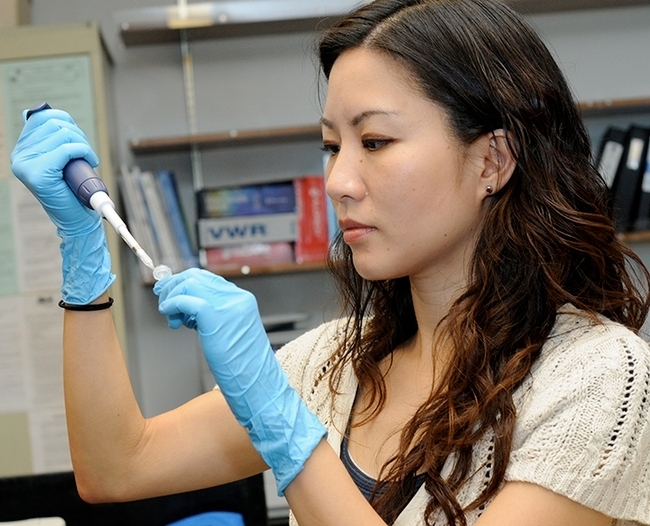
- Author: Kathy Keatley Garvey
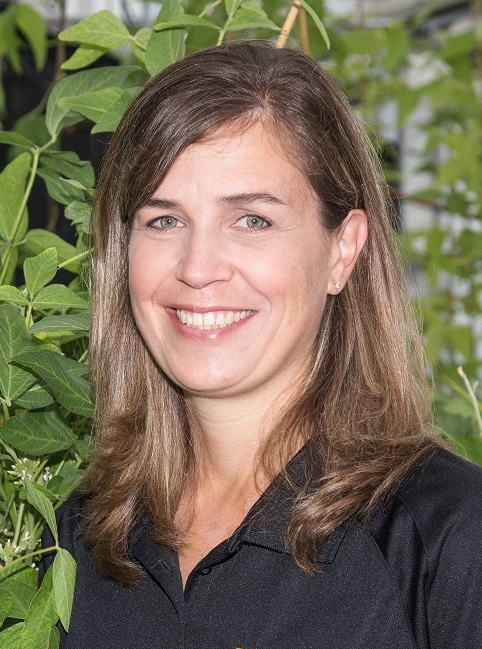
Well, how about nematodes? They can do "tricks," too.
Professor and plant pathology researcher Melissa Mitchum of the Department of Pathology, University of Georgia, willpresent the next UC Davis Department of Entomology and Nematology seminar.on "The Tricks Phytonematodes Use to Modulate Plant Development."
Her virtual seminar begins at 4:10 p.m., Pacific Time, on Wednesday, March 9, announced seminar coordinator and nematologist Shahid Siddique, assstant professor, UC Davis Department of Entomology and Nematology.
"Phytonematodes secrete a suite of effectors to modulate developmental programs of their hosts to cause disease," Mitchum says in her abstract. 'In this talk, I will highlight what we are learning about these effectors and the tricks they use to accomplish their goals."
Along with colleague Lisa Beamer of the University of Missouri, Mitchum is co-directing a four-year $1.2 million grant from the joint National Science Foundation and the U.S. Department of Agriculture National Institute of Food and Agriculture Plant-Biotic Interactions Program "to help combat a devastating soybean pathogen," according to a January 2022 news article in the Johnson City Press, Tenn. "The soybean cyst nematode, a microscopic roundworm, is responsible for annual crop losses of $1 billion in the U.S. alone," the news story relates.
Mitchum's research focuses "on molecular plant-nematode interactions with an emphasis on the sedentary endoparasitic cyst and root-knot nematodes," Mitchum says on her website. "Pathosystems include cyst (Heterodera glycines) nematode on soybean, cyst (Vittitadera zeaphila) nematode on corn, and root-knot (Meloidogyne spp.) nematodes on soybean, cotton, and peanut. We utilize the model plant Arabidopsis to accelerate our studies to dissect the molecular basis of parasitism by cyst (Heterodera schachtii) and root-knot nematodes. Our work addresses plant responses during compatible and incompatible plant-nematode interactions, the identification and functional analysis of nematode stylet-secreted effector proteins, and developmental reprogramming of host root cells via peptide mimicry and phytohormone manipulation. I work closely with plant breeders to develop high yielding, nematode resistant varieties. Current efforts are also focused on translating basic discoveries to develop novel approaches for nematode resistance in crop plant."
Mitchum received her bachelor's degree in biology in 1993 from the University of Puget Sound, Tacoma, Wash., and her master's degree in plant pathology from the University of Nebraska, Lincoln, in 1995. She obtained her doctorate in plant pathology, with a minor in biotechnology, from North Carolina State University, Raleigh, in 2001. Mitchum served as a postdoctoral fellow with the Developmental, Cell and Molecular Biology Group at Duke University in 2003.
For any seminar technical issues, Siddique may be reached at ssiddique@ucdavis.edu.
Want to learn the basics of nematodes, aka roundworms? Be sure to watch nematologist Steve Nadler, professor and chair of the UC Davis Department of Entomology and Nematology in this YouTube video. He delivered this presentation virtually at the 2021 UC Davis Biodiversity Museum Day. He discusses what they are and why they're important to the ecosystem.
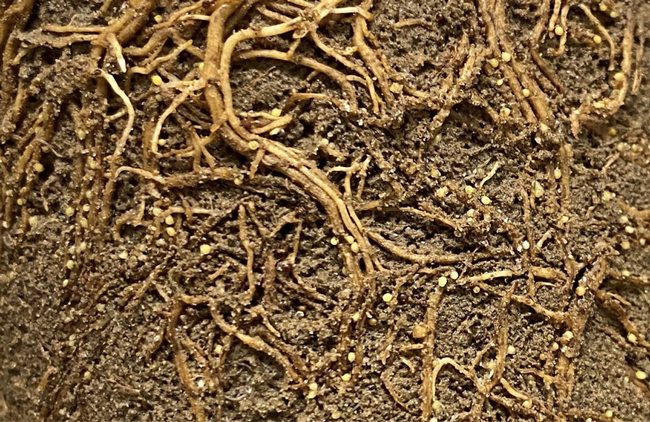
- Author: Kathy Keatley Garvey
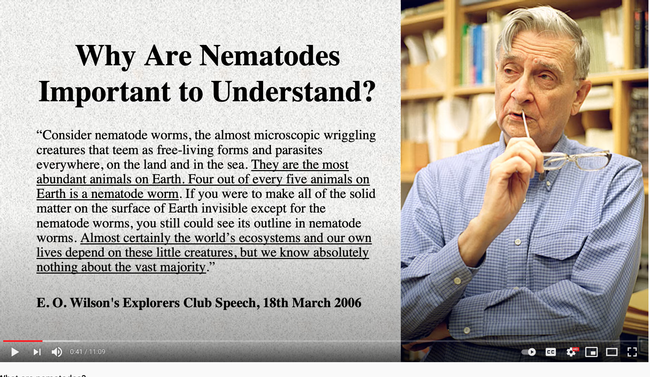
That's a question that nematologists are frequently asked.
Well, just in time for the UC Davis Biodiversity Museum Month (that would be our month of February!), nematologist Steve Nadler, professor and chair of the UC Davis Department of Entomology and Nematology, answers that very question in his 11-minute YouTube video, https://youtu.be/3fhv-P_O8I8. .
Nematodes are known as "round worms" and most are microscopic, he says in his family friendly, easy-to-understand video.
"The famous naturalist E. O. Wilson who studies ants notes that 80 of the individual animals living on the earth are nematodes," Nadler says. "They are clearly important to the earth's ecosystems, even if we don't fully understand all the things that they do, and as parasites they affect human health, the health of other animals, and reduce our food production so they're clearly important in that respect."
You'll want to watch the rest of it.
Nematodes are just one of the topics of videos posted on the UC Davis Biodiversity Museum Month website. Others affiliated with the UC Davis Department of Entomology and Nematology focus on butterflies, moths, arachnids, millipedes, and how to collect, preserve and identify insects.
Other videos posted on this site for free, public viewing include:
- "Virtual Tour of the Bohart's Lepidoptera Collection," a 13-minute Aggie Video by Diane Ullman, professor and former chair of the UC Davis Department of Entomology and Nematology. She describes the natural history and ecology of several colorful and toxic species in the Bohart Museum of Entomology. See https://bit.ly/2LHYFzL
- "Insect Collection, Preservation and Identification," a 15-minute Aggie Video by Steve Heydon, senior museum scientist, Bohart Museum of Entomology. Heydon, the curator and collections manager of the Bohart Museum, gives an overview of how the museum collects, preserves and identifies some of its nearly 8 million specimens. See https://bit.ly/375eXdC
- "Common Millipedes of the Sacramento-San Francisco Region," a 23-minute YouTube video by Xavier Zahnle, a doctoral student in the lab of Professor Jason Bond lab, the Schlinger Chair in Systematics. Zahnle reviews the major groups of millipedes that are commonly found in the region, the diversity, and what makes them unique. See https://youtu.be/ZMAzm3A95VE
- "Demonstration of Insect Preparation: Butterflies and Moths," a 9-minute Aggie Video featuring Jeff Smith, curator of the Lepidoptera collection at the Bohart Museum of Entomology. He describes how to pin and spread moths and butterflies. This technique is the most common method that museums and researchers use to display adult Lepidopterans, allowing scientists to identify and study this diverse group of insects. See https://video.ucdavis.edu/media/0_9nymgt3c
- "All About Arachnids," a 24-minute YouTube video by Lacie Newton, a doctoral student in the lab of Professor Jason Bond lab, the Schlinger Chair in Systematics. She talks about the diversity of arachnids (spiders, scorpions, ticks, mites etc.) and their unique characteristics. https://youtu.be/FM_ANqARkI0
Other topics range from the Phaff Yeast Collection, California Raptor Center and the Museum of Wildlife and Fish Biology to the UC Davis Arboretum and Public Garden. More videos, including one on the diversity of bees by Chris Casey, manager of the UC Davis Department of Entomology and Nematology's bee garden, the Häagen-Dazs Honey Bee Haven, are being loaded throughout the month of February. To access all of the pre-recorded videos and activities, click here. To access the schedule of live talks and demonstrations, click here.
About the UC Davis Biodiversity Museum Month
The 10th annual UC Davis Biodiversity Museum Month program is all virtual this year via webinars and pre-recorded presentations. All take place throughout the month of February. The science-based event traditionally occurs on only one day--the Saturday of Presidents' Weekend, when families and friends gather on campus to learn first-hand about the UC Davis museums and collections.
This year's biodiversity event focuses on 12 museums or collections:
- Anthropology Museum
- Arboretum and Public Garden
- Bohart Museum of Entomology
- Botanical Conservatory
- California Raptor Center
- Center for Plant Diversity
- Häagen-Dazs Honey Bee Haven
- Nematode Collection
- Marine Invertebrate Collection
- Museum of Wildlife and Fish Biology
- Paleontology Collection
- Phaff Yeast Culture Collection
One of the activities listed in the pre-recorded talks and activities is a 10-page coloring book on plant-insect interactions. It's the work of Molly Barber, Fernanda Guizar, Collin Gross and Jasen Liu of the Santiago Ramirez lab, UC Davis Department of Evolution and Ecology. Ramirez is a global authority on orchid bees. Download the PDF of the coloring book here.
To help support the Biodiversity Museum event, contributions are being accepted through a month-long crowdfunding campaign program at https://crowdfund.ucdavis.edu/project/24310.

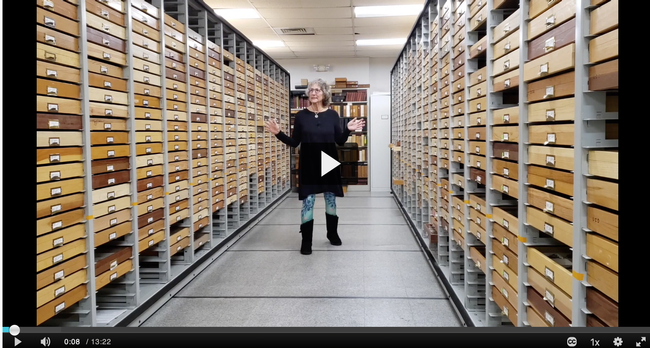
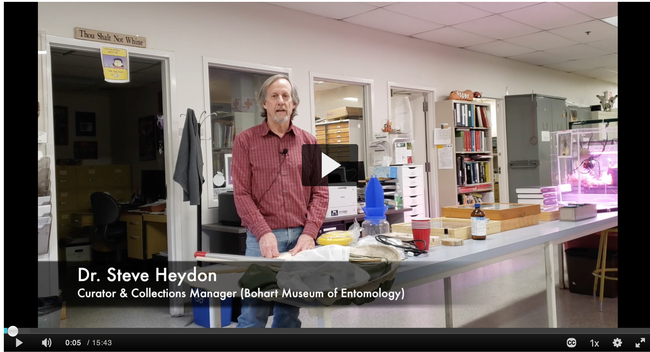
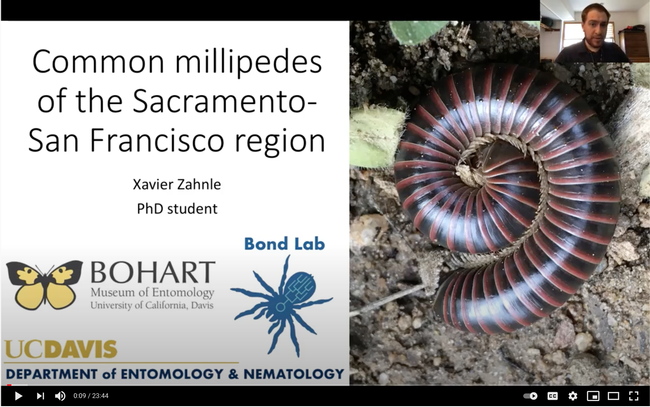
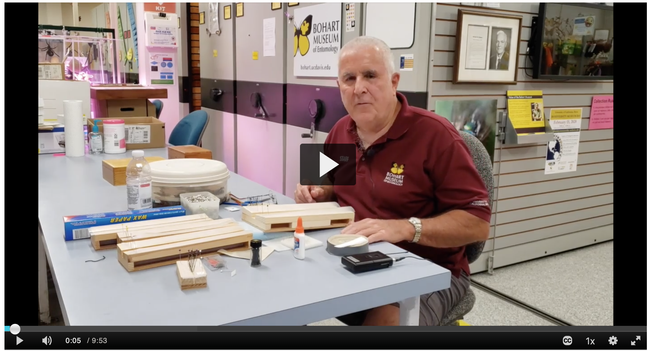
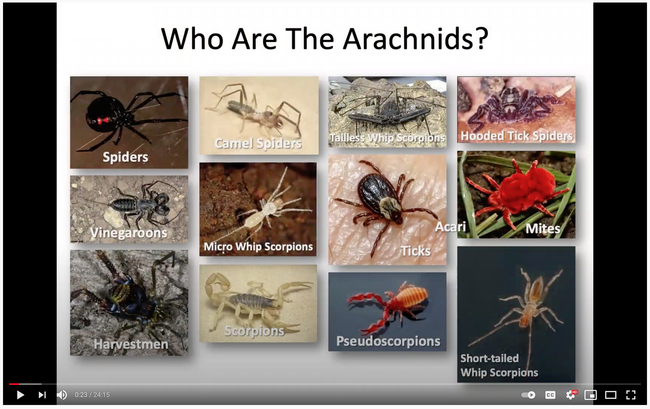
- Author: Kathy Keatley Garvey

If you're a gardener, you're aware that nematodes are "microscopic, eel-like roundworms" and that "most troublesome species in the garden are those that live and feed within plant roots most of their lives and those that live freely in the soil and feed on plant roots," according to the UC Integrated Pest Management Program website on nematodes.
If you attended the ninth annual UC Davis Biodiversity Museum Day, you learned hands-on information from nematologists Christopher Pagan and Corwin Parker, doctoral students who study with major professor Steve Nadler, professor and chair of the UC Davis Department of Entomology and Nematology.
Pagan and Parker held forth at their display in the Academic Surge Building, where they fielded questions about nematodes and showed specimens to the visitors. The nematode collection was one of 13 museums or collections featured at the Biodiversity Museum Day, always held the Saturday of Presidents' Weekend.
Many visitors asked what nematodes are, they related.
Other common questions asked:
- Do I have nematode parasites?
- How dangerous are nematode parasites/can they kill you?
- How long do they live?
- How many species ofode are there?
- Are soil nematodes good or bad for my garden?
Parker shared some of the answers:
Do I have nematode parasites?
Probably not unless you've been traveling a lot. The most common nematode parasite of humans in the US is pinworm which most children get, but not adults. Worldwide however, hundreds of millions of people are infested with parasites including Ascaris, hookworm, and whipworm.
How dangerous are nematode parasites/can they kill you?
Nematode parasites are usually relatively benign unless you have a lot of them. Potentially fatal exceptions do exist, such as zoonotic infections of rat lungworm and raccoon roundworm, but those are rare.
How long do nematodes live?
It depends on the species and life history. Parasitic nematodes can live for a long time, while most free-living nematodes have relatively short lifespans. Some nematodes that live in harsh environments such as deserts can extend their lives by going into a state of suspended animation until environmental conditions are optimal.
How many species of nematode are there?
More than 30,000 described species, but it's estimated there are more than 1 million total.
Are soil nematodes good or bad for my garden?
Most soil nematodes are neutral to beneficial for your garden. They're an integral part of the soil ecosystem and help with nutrient cycling, and some kill of root-feeding insects. There are some plant-parasitic nematodes, but most don't cause significant damage.
UC Davis Biodiversity Museum Day
In addition to the nematode collection, the UC Davis Department of Entomology and Nematology showcased the Bohart Museum of Entomology and the Häagen-Dazs Honey Bee Haven. Other participating museums or collections at this year's Biodiversity Museum Day: the Botanical Conservatory, Arboretum and Public Garden, California Raptor Center, Museum of Wildlife and Fish Biology, Paleontology Collection, Phaff Yeast Culture Collection, Viticulture and Enology Culture Collection, Anthropology Museum, Center for Plant Diversity, and Marine Invertebrate Collection.
Here's a glimpse of the Biodiversity Museum Day activities at the Bohart Museum of Entomology and the Häagen-Dazs Honey Bee Haven.
If you missed it, calendar the 10th anniversary Biodiversity Museum Day in 2021. The event always takes place the Saturday of Presidents' Day Weekend.
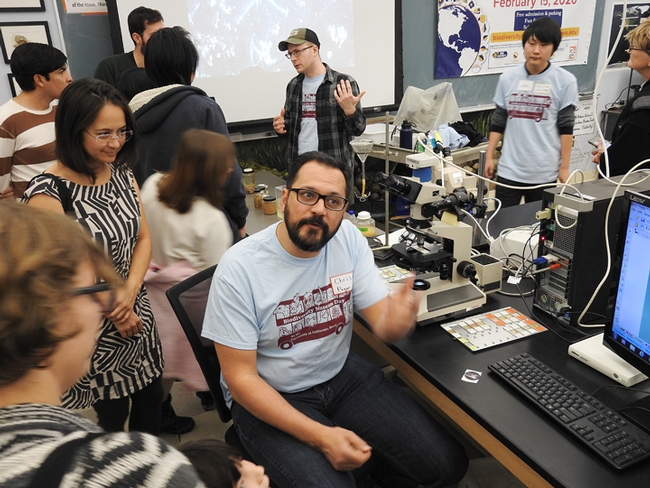
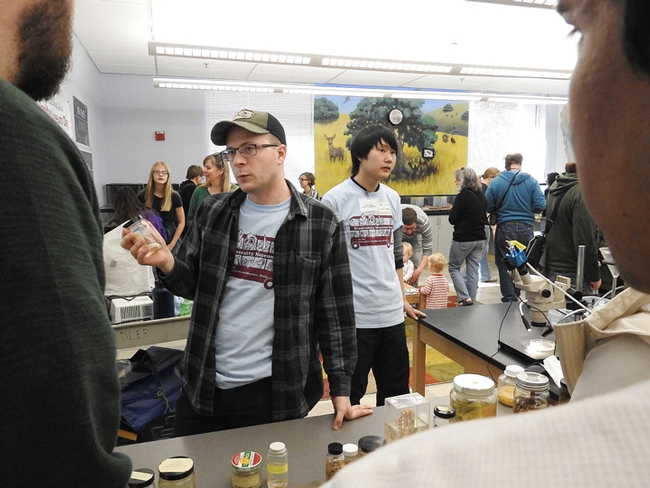
- Author: Kathy Keatley Garvey
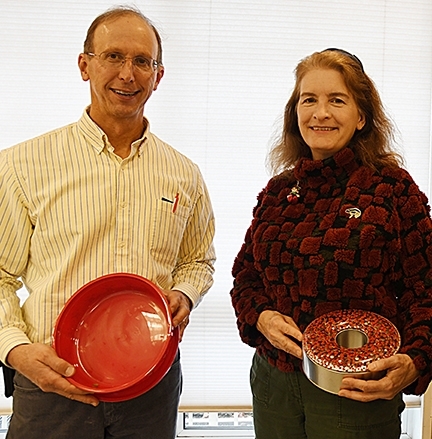
Sounds like a great story, right?
Make that great cookies.
They weren't there to present their research on nematodes, aquatic insects or pollinators. They were there to enjoy some camaraderie at the UC Davis Department of Entomology and Nematology's holiday party, and...drum roll...they won the top prizes in the cookie contest.
- Best chocolate cookie: Aquatic entomologist Sharon Lawler, professor, UC Davis Department of Entomology and Nematology, for her recipe, "Dirty Drunk Snowballs"
- Best non-chocolate cookie: Nematologist Steve Nadler, professor and chair, UC Davis Department of Entomology and Nematology, for his Internet-modified recipe, "Cranberry Orange Cookies"
- Best decorated cookie: Community ecologist Rachel Vannette, assistant professor, UC Davis Department of Entomology and Nematology, for her "Stamped Citrus Shortbread" recipe from the New York Times
William Tuck, academic personnel specialist in the Phoenix Cluster, which serves the Department of Entomology and Nematology and the Department of Plant Pathology, coordinated the event and awarded $25 Amazon gift cards to the winners.
The proof of the pudding? Empty containers.
Want to make the recipes? They shared!
Dirty Drunk Snowballs
By Sharon Lawler
Ingredients:
1 box Trader Joe's Mini Dark Chocolate Mint Stars
1/4 cup dark rum (white rum or bourbon will also work)
1/4 cup confectioner's sugar
Method:
Grind up the cookies in a food processor or blender until pretty fine but with some texture left. Stir enough dark rum so that the crumbs hold together well, but stop before it gets soggy. Let the mix sit for 15 minutes or so. Sift the confectioner's sugar into a bowl. Roll the mix into small balls, and then roll them in the confectioner's sugar.
Cranberry Orange Cookies
By Steve Nadler
Internet-modified recipe
Ingredients:
1 cup unsalted butter, softened
1 cup granular white sugar
1/2 cup brown sugar (packed)
1 egg
1-1/2 teaspoons grated orange zest
5 tablespoons orange juice
2-1/2 cups all-purpose flour
1/2 teaspoon baking soda
1/2 teaspoon salt
2 cups orange-flavored dried cranberries (Trader Joe's)
1-1/2 cups confectioner's sugar
Method:
- Use a food processor to chop the dried cranberries
- Preheat oven to 375 degrees F.
- In a large bowl, blend together the butter, white granular sugar, and brown sugar until smooth.
- Whisk the egg in a small bowl, then mix into the large bowl.
- Add 1 teaspoon of orange zest and 2 tablespoons of orange juice into the large bowl and mix.
- In a separate bowl, mix together the flour, baking soda, and salt.
- Stir the flour mixture from step 6 into the large bowl.
- Mix in the chopped cranberries, working to distribute them evenly.
- Drop cookie dough mixture (rounded tablespoon) on ungreased cookie sheets. Space them 2 inches apart.
- Bake for about 12 minutes in the preheated oven (375 F). The edges will begin to turn golden brown when ready.
- Remove cookies from sheets and cool on wire racks.
- In bowl, mix 1/2 teaspoon orange zest, 3 tablespoons of orange juice, and the confectioner's sugar until smooth. Brush on the tops of the cooled cookies. Let dry.

By Rachel Vannette
Recipe from New York Times
For the Cookies
- 2 cups/255 grams all-purpose flour, plus more as needed
- ⅓ cup/45 grams cornstarch
- ½ teaspoon kosher salt
- 1 cup/225 grams unsalted butter (2 sticks), softened
- ½ cup/100 grams granulated sugar
- 1 orange (preferably tangelo)
- 1 lemon
- ½ teaspoon vanilla extract
- ½ teaspoon lemon extract
- ¾ cup/75 grams sifted confectioners' sugar
- 1 tablespoon melted butter
- 1 tablespoon fresh orange juice, plus more as needed
For the Glaze:
- 3/4 cup/75 grams sifted confectioners' sugar
- 1 tablespoon melted butter
- 1 tablespoon fresh orange juice, plus more as needed
Preparation
- Prepare the cookies: Add flour, cornstarch and salt to a medium bowl, and whisk to combine. Set aside.
- Combine butter and granulated sugar in the bowl of a stand mixer fitted with the paddle attachment. Zest half the orange and half the lemon directly into the bowl. Reserve the lemon and orange for the glaze. Cream the butter mixture on medium-high speed until light and fluffy, 2 to 3 minutes. Add vanilla and lemon extracts and beat on medium speed until well combined, scraping the bowl a few times as needed.
- Add the flour mixture to the butter mixture and beat on low speed just until combined. Scrape the bowl and fold a few times to make sure everything is well combined. Wrap dough in plastic wrap, flatten into a disk, and chill until firm, at least 1 hour, and up to 3 days.
- Heat oven to 350 degrees. Cut dough in half and let one piece warm up for 30 minutes if it has chilled longer than an hour. Return the other half to the refrigerator. Portion the dough into pieces roughly the size of walnuts (a scant 2 tablespoons/about 35 grams), then roll each piece into a ball between your hands. One at a time, dip a ball of dough into flour and set on work surface. If dough balls soften too much, return them to the refrigerator to firm up for a few minutes. You want it cool, but malleable. Dip cookie stamp in flour, and press down on the ball of dough until it is about 1/4-inch thick. Remove stamp. (If dough sticks to stamp, carefully peel it off. Don't worry about excess flour as you will brush it off after chilling.) Trim the edges using a 2-inch cookie cutter, and transfer dough rounds to 2 parchment- or silicone mat-lined baking sheets, arranging them about 1 1/2 inches apart. Repeat with remaining dough.
- Once you have stamped out all the cookies, knead together the scraps to make a few more. Chill in the freezer until very firm, about 10 minutes. When cold, brush off any excess flour with a dry pastry brush.
- Bake until cookies just start to turn golden underneath, 12 to 14 minutes, switching the baking sheets from front to back and top to bottom halfway through baking time.
- Make the glaze while the cookies bake: Zest the remaining skin from the reserved lemon and orange into a small bowl. Add the confectioners' sugar, butter and orange juice and whisk until smooth. If glaze is too thick, add more orange juice. If it is too thin, add more confectioners' sugar. It should be the consistency of thin custard.
- Let the cookies cool for a few minutes on the baking sheets, and transfer to a wire rack set over a parchment- or wax paper-lined baking sheet. Pick up a cookie, and using the back of a small spoon, spread a generous teaspoon of glaze on a cookie, letting any excess drip onto the next cookie. Repeat until all the cookies are glazed. Cool completely. Cookies will keep in an airtight container at room temperature for up to 1 week.

